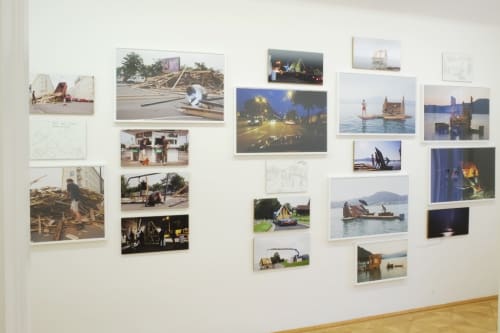UTOPIE WOHNRAUM is the name of the new exhibition, which will be on show at the bechter kastowsky gallery in Vienna from 10 March and brings together works by Lorenz Estermann, Aldo Giannotti (courtesy of Projektraum Viktor Bucher, Vienna), Manfred Grübl / Werner Schrödl and Fritz Panzer (courtesy of Galerie Krobath, Vienna).
Utopia - according to the definition of the term, "an idea that is so unrealistic or fantastic that it cannot be realised." - is the trigger for the works on display. The reference to the living space of everyday life and the social need for personal protection are the basic ideas behind all the works on display.
The exhibition was made possible by the co-operation with Krobath Gallery, Vienna and Viktor Bucher, Vienna.
In his models, Lorenz Estermann translates the idea of collage into three-dimensional three-dimensionality on the one hand and questions the meaningfulness of model making itself on the other. Once you have decided on your house in your idyllic private life, as a builder you often want to own a model of it. This is then viewed, rotated, mentally furnished, you begin to feel comfortable in it - the model as a joyful anticipation of reality. Lorenz Estermann looks for his models in monotonous rural areas: abandoned bus shelters, bathing huts at lakes, empty kiosk buildings. These are photographed and integrated into painterly collages, but also modelled freely, detached from the actual model. Beautiful models are created, but their beauty remains in their model character - they do not create a dream image of one's own four walls, often not even feasible due to their accessibility - they are always on stilts without ladders or even stairs. The models are what they are - spatial paintings whose indices of the living area remain stuck in utopia.
Aldo Giannotti always pursues a question that explores possible answers to the point of irony: The iron temple of the museum, for example, depicted in the middle of a continuous motorcade, with the descriptive sentence typical of Giannotti: ‘Drive through museum’. The smile is part of the viewer's reaction; it is based on the interplay of representation and writing. And yet his works are more than just humorous ‘comic scenes’: they are evidence of a deep sociological examination of our society. Recently awarded the Pomilio Blumm Prize, Milan, Aldo Giannotti is showing drawings on the theme of New York at the bechter kastowsky gallery: living on a grand scale, skyscrapers, crowds and urban structures are just some of them and will certainly make many a visitor think, but also grin. (Aldo Giannotti, courtesy of Projektraum Viktor Bucher, Vienna)
With their joint work ‘one day home’, Manfred Grübl and Werner Schrödl have posed a completely different - practical - question: is it possible to build and live in a house in a total of 48 hours and leave it standing in the legal sense? With the help of passers-by, the two artists build a house in a square in Vienna's 2nd district within 24 hours using demolition timber: it is accessible, the roof can be opened, the furniture is variable. What is important to both of them is the place where this house is being built: in an urban environment. In the middle of a street surrounded by coffee houses, sausage stands and car parks. After completion, the building is transported to Lake Attersee in a heavy goods vehicle, where it suddenly becomes a kind of residential boat. The artists spend a day and a night floating in ‘their’ four walls: the bed becomes a dinghy, the wardrobe a floating side buoy. The entire project is based on Ottoman-Islamic customary law (‘Gecekondu’, German: ‘overnight’), which allows a dwelling erected on public land to be left standing and inhabited for one night. The local question of basic rights on the lake is another aspect of this work.
Fritz Panzer, on the other hand, draws his rooms. With pencil on paper, but also with wire in space. As a draughtsman, but also as a painter, he manages to bring out the essentials with just a few strokes. In the kitchen shown by the bechter kastowsky gallery, however, this drawing is transformed: the line enters the room. Recognisable details, such as the tiles, the pots in the sink, the potholders or even the kitchen boxes, no longer remain on the surface; we encounter the drawing. Whereas in Pollock's time the saying ‘To be in the painting’ was still the credo of the abstract expressionists, here we could literally speak of ‘to be in the drawing’. The viewer enters and the artist makes the drawing accessible but not usable. In addition to the kitchen, there are also everyday objects that make up a living space and will be present in the exhibition in the utopia of the three-dimensional drawing: a record player and various milk cartons. (Fritz Panzer, courtesy of Galerie Krobath, Vienna)



